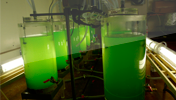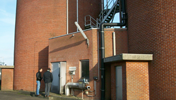Perlemax
Algae Growth & Harvesting
The use of algae as a method of carbon capture has gained significant interest with major industrial companies seeking to investigate its practicality as a way of offsetting carbon emissions. Algae has uses in a variety of industries such as a food source for farming and as a source for biofuels.
Algae Growth
A feasibility study has been completed to determine the viability of D. salina being dosed with steel plant stack gas, combusted from offgases of the steel making process, and used in the power plant. Such gases have a high CO2 content and with rapid mass transfer from microbubble mediated, air lift loop induced mixing, and easily result in saturation of the liquid phase.
Generally, previous observations have that high dissolved CO2 levels are not conducive to higher algal biomass growth. From this basic objective, the pilot trials were successful as both showed 100% survivability.
The trials had a second, more fundamental objective, which was to test the hypothesis that microbubble mediation strips out the O2 and thus removes the inhibition to growing to higher density and with faster growth rates. Gas monitoring and analysis demonstrate that O2 was stripped to the equilibrium level to that of the stripping exhaust gas. Steady chlorophyll growth, and accelerating exponential growth of biomass, are consistent with stripping the O2 having removed the inhibitory effect.
See this open access article for a summary of microalgae growth studies when mediated by CO2-rich microbubbles:
Ying K., Gilmour DJ, Zimmerman WB, Periodic CO2 Dosing Strategy for Dunaliella salina Batch Culture, Int. J. Mol. Sci. 16(5): 11509–11521,2015.
This study shows the disinfection effect of ozone-rich microbubbles at low sparging rates, and “cheap” cell lysis for extraction of lipids at high sparging rates:
Kamaroddin MF, Hanotu JO, Gilmour DJ, Zimmerman WB, “In-situ disinfection and a new downstream processing scheme from algal harvesting to lipid extraction using ozone-rich microbubbles for biofuel production”, Algal Research 17:217-226, 2016.
Algae Harvesting
Use of Perlemax’s Microbubble technology to achieve Algae seperation has shown overall recovery efficiency of algal biomass at 99.2%. Due to the low energy costs of Perlemax’s microbubble technology the high energy cost associated with dissolved air flotation and the inefficiency of conventional dispersed air flotation are alleviated. Perlemax’s microbubble technology uses a maximum of 1.2 bar pressure compares to DAF’s 5 bar with significantly reduced flow rate.
Our first, lab-scale study of microbubble mediated flotation is reported below. We have a pilot scale version with robust diffusers and no metal coagulants:
James Hanotu, H.C. Hemaka Bandulasena, William B. Zimmerman, Microflotation Performance for Algal
Separation, Biotechnology and Bioengineering, 109(7), 1663–1673, 2012.
DownloadMicroflotation For Algal Separation PDF
- info@perlemax.com
- Perlemax Ltd
- Kroto Innovation Centre
- 318 Broad Lane
- Sheffield
- S3 7HQ

Algae Growth & Harvesting
Investigate the feasibility of growing microalgae using CO2 rich steel plant exhaust gas.

Biorefining Operations
Microbubble distillation and fermentation have great promise as unit operations in biorefining.

Anaerobic Digestion
Explore how Perlemax is perfecting a method to break down plant and animal materials by microorganisms in the absence of oxygen.

